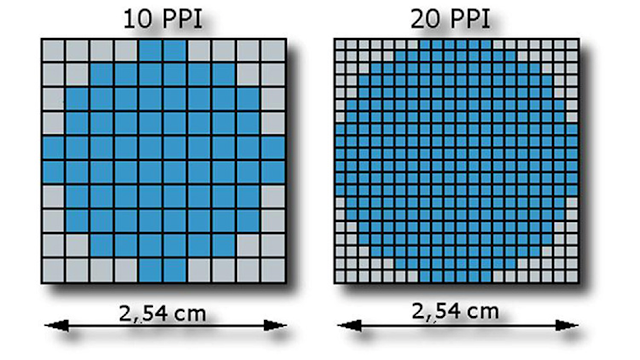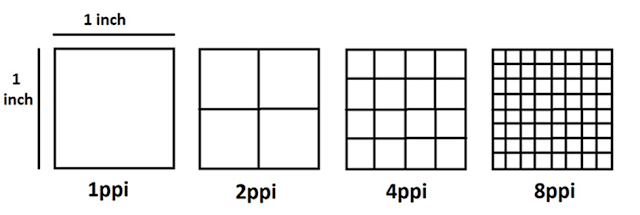All of the systems that can display images such as mobile phones, tablets, laptops, computer monitors and televisions that we use or see in our daily life all have a screen. These screens are basically made up of tiny dots that emit light. We call each of these tiny dots that emit light a "pixel".
In other words, pixel; It is the smallest unit that
the human eye can distinguish in an image that occurs on a screen. Each of the
light-emitting pixels on a screen consists of red, blue and green sub-pixels. Of
course, it is not possible for the human eye to see this. Pixel is derived from
the words “Picture Element” as a name. Although referred to as a
"dot", a pixel is actually a square. Everything we see on a digital
screen is revealed by the different arrangement and coloration of the pixels.
What is Resolution?
PPI is often used to mean "pixel density" and returns the number of pixels per inch (2.54 cm). As the PPI value of a screen increases, the sharpness of the image increases. This value changes according to the size and resolution of the screen used in the device. However, we can say that some companies give misleading information about PPI values. For example, in two devices with the same screen and resolution, a company adds sub-pixels to this value and gives very high PPI values in their technical specifications. This value should not be confused with DPI – the dots per inch. While PPI is a term related to digital displays, DPI is more of a related term to printing systems.
Depending on the screen type in digital systems, the number of pixels and color combinations differ. Pixel is basically accepted as a unit of measurement in digital displays. The number of pixels a digital display has on the horizontal and vertical axes is called “resolution”.
For example; On a digital screen with a resolution of
1920×1080, the number 1920 refers to the pixels on the horizontal axis and the
number 1080 refers to the pixels on the vertical axis. In the
IT world, a screen with a resolution of 1920×1080 is called Full HD. The Full HD resolution format is called 1080p because it is named
according to the vertical pixel ratio. 1280 horizontal pixels and 720 vertical
pixels are values on a screen whose pixel value is shown as 1280×720 in a
different way. Likewise, a screen with a resolution of 1280×720 is
called HD (High Definition – HD) in the IT world. The HD resolution format is
called 720p because it is named according to the vertical pixel ratio.
The letter "p" next to resolutions means
"progressive scan", not pixels. Sometimes you can see the letter “i”
next to the given resolution. The letter "i" here stands for
"interlaced scan". Neither of these terms has anything to do with
resolution directly. 1080p and 1080i refer to the same resolution values. In
general, progressive screening is preferred more frequently nowadays. The main
reason for this is that there is less flicker on the screen in scenes with fast
transitions such as action, sports, racing scenes. Interlaced scan is similar
to the image created on the screen of large-backed CRT televisions, which we
used to call tube televisions in our homes or workplaces.
In the video above, progressive scan – progressive
scan – and interlaced scan – are compared.
Resolution Systems and Nomenclature
·
High Definition (HD): 1280×720 – 720p
·
Full HD (FHD): 1920×1080 – 1080p
· 4K Ultra HD (UHD): 3840×2160 – 2160p
· 8K Ultra HD (UHD): 7680×4320 – 4320p
The resolution values that we encounter most in
devices in daily life are as above. Different names are given with different
resolution values. All of these resolutions are in 16:9 format. With the rapid
advancement of technology, screen resolutions have also increased. It is almost
impossible to encounter screen resolutions lower than 1280×720, that is, 720p,
on today's screens. Today, devices such as 4K and 8K, called UHD, are rapidly
becoming widespread. Some brands have 5K models with a resolution of 5120×2700,
and 6K models with a resolution of 6016×3384. Also every 5K, 6K etc. a model
does not have a standard resolution value. When the ratio changes, the resolution
value on the horizontal and vertical axis automatically changes.
As of now, the most popular screens (monitor,
television, etc.) are models with 8K resolution. Models of this type are sold
at very high prices. However, there is a resolution system of different values
such as 1280 x 768, 1440 x 720, 2048 x 1080, 2560 x 1440. In general, these
types of resolutions apply to screens such as smartphones and laptop or
computer monitors. Some authorities do not accept them as a basic resolution
value, as they do not conform to the 16:9 format.
As the screen resolution value
increases, the load on hardware units such as processor and video card also
increases. For this reason, all the components that the device has or will have
must be compatible with each other. Using a high resolution display on a device
with low components may cause performance problems. Quality perception may
change depending on the screen type used in the device. For example; some
screen models have slightly paler colors, while some models have more vivid and
bright colors. Therefore, this quality perception has nothing to do with
resolution. You can choose the most suitable image for you by changing the
display modes of the screen.
Today, there are prototype screens produced as prototypes with 10K resolution. (In 2015, the Chinese display manufacturer BOE produced the world's first 10K resolution television.) However, broadcasting in high definition is still very difficult. The main reason for this is that a high resolution video/broadcast takes up as much space as possible and the internet/wireless connection speeds are insufficient to meet these values. In short, the limited quality of broadcasts supported by the latest technology screens in your hand means that you will not be able to get full performance from your devices in general. Imagine that you cannot exceed 100 km/h with the latest model Bugatti Veyron you have. If you're going at this speed, do you need a Bugatti Veyron?
Of course, it should be noted that very
high resolution values are not as attractive to users as they used to be.
However, resolution values will continue to increase exponentially if solutions
are found to these problems in the coming days. On the market, you can find
many models with 8K resolution. However, the prices of these screens are quite
high. While this is the case, even 8K televisions are difficult to buy, while
it is a matter of debate how much 10K resolution televisions are
"needed" at this stage. However, it is pleasing that the developments
in information technologies are progressing rapidly.




Comments
Post a Comment